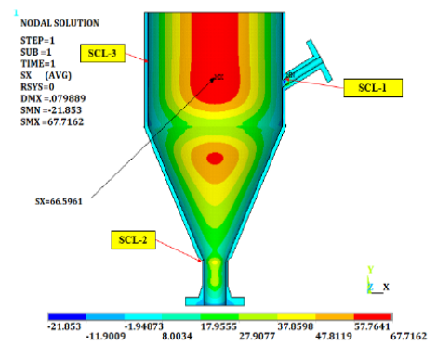


Indian Journal of Science and Technology
DOI: 10.17485/IJST/v17i12.3272
Year: 2024, Volume: 17, Issue: 12, Pages: 1148-1158
Original Article
Ishwar Gophane1*, Narayan Dharashivkar2, Pramod Mulik3, Prashant Patil2
1M.Tech. Student, Mechanical, TKIET, Warananagar, 416113, Maharashtra, India
2Professor, Mechanical, TKIET, Warananagar, 416113, Maharashtra, India
3Professor/HoD, Mechanical, TKIET, Warananagar, 416113, Maharashtra, India
*Corresponding Author
Email: [email protected]
Received Date:30 December 2023, Accepted Date:28 February 2024, Published Date:14 March 2024
Objectives: This study tests the vessel strength and performance of pressure vessel under Internal pressure, Nozzle loads, and Hydro-test using Ansys APDL, validating design alignment with ASME Section VIII following the Design by rule (Analytical) and Design by Analysis (FEA) accurate elastic analysis approach. Methods: This study employs ASME methods to validate vessel integrity under various loads. Strength is confirmed through analytical formulas and Finite Element Analysis (FEA) using ANSYS APDL, aligned with widely used ASME BPVC codes in the oil and gas industry. The FE model, utilizing hex elements, ensures result accuracy with a minimum of three elements across thickness. Boundary conditions are validated by comparing hoop stress in FEA with analytically calculated values. ASME's computationally efficient elastic analysis, employing a linear approach, includes stress linearization at discontinuity and non-discontinuity locations, verifying vessel design through analysis. Findings: Initial thicknesses for the shell and cone exceeded analytically calculated minimums, affirming vessel structural integrity through ASME's design by rule approach. Finite Element Analysis (FEA) stress analysis at critical points, such as nozzle junctions and other discontinuity areas, validates accuracy through hoop stress checks. Analysis of design and test load cases reveals stress categories well within ASME Sec VIII limits, confirming the vessel's safety and compliance with elastic stress analysis standards. Novelty: This method emerges as a reliable tool for vessel design, ensuring safety and ASME compliance, particularly beneficial for industries like oil and gas. It provides precise guidelines utilizing hex mesh, validates boundary conditions through hoop stress comparison, and comprehensively assesses stress in critical and non-critical zones through elastic stress analysis. Addressing common challenges identified in the literature review, this approach enhances the accuracy and reliability of pressure vessel designs in compliance with ASME standards for design and test loadings.
Keywords: Pressure Vessels, Process Industries, Stress, Loads, Pressure, Thermal, Design Validation, ASME, FE analysis
© 2024 Gophane et al. This is an open-access article distributed under the terms of the Creative Commons Attribution License, which permits unrestricted use, distribution, and reproduction in any medium, provided the original author and source are credited. Published By Indian Society for Education and Environment (iSee)
Subscribe now for latest articles and news.